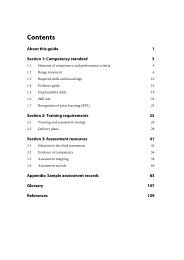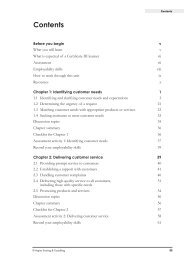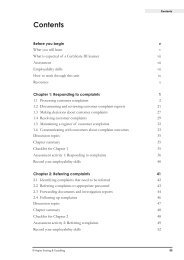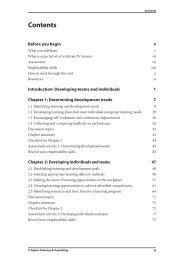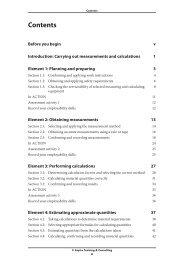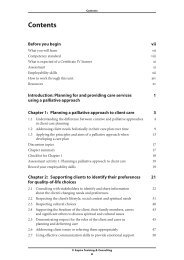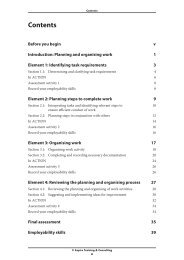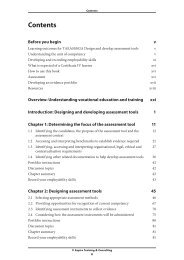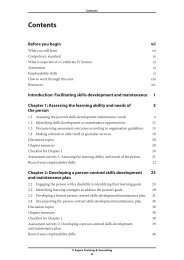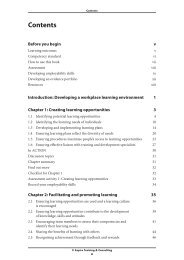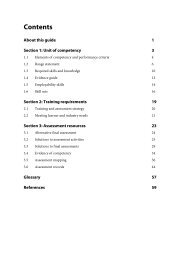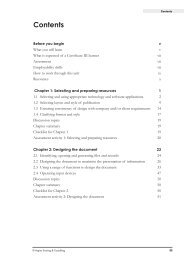view sample - Aspire Learning Resources
view sample - Aspire Learning Resources
view sample - Aspire Learning Resources
Create successful ePaper yourself
Turn your PDF publications into a flip-book with our unique Google optimized e-Paper software.
Contents<br />
Microsoft Office 2010 version 1<br />
About this guide 1<br />
Section 1: Unit of competency 3<br />
1.1 Elements of competency and performance criteria 4<br />
1.2 Range statement 6<br />
1.3 Required skills and knowledge 10<br />
1.4 Evidence guide 11<br />
1.5 Employability skills 13<br />
1.6 Skill sets 15<br />
1.7 Recognition of prior learning (RPL) 16<br />
Section 2: Training requirements 17<br />
2.1 Training and assessment strategy 18<br />
2.2 Delivery plans 20<br />
Section 3: Assessment resources 27<br />
3.1 Alternative final assessment 28<br />
3.2 Solutions to assessment activities 32<br />
3.3 Solutions to final assessments 44<br />
3.4 Evidence of competency 54<br />
3.5 Assessment mapping 56<br />
3.6 Assessment records 62<br />
Glossary 72<br />
References 75
About this guide<br />
This guide is for trainers and assessors of unit BSBITU202A Create and use spreadsheets.<br />
It complements the corresponding <strong>Aspire</strong> learner guide.<br />
As a trainer, you must develop and use training and assessment strategies that embrace<br />
the learner’s needs, educational background, preferred learning style and meet the<br />
requirements of the training package.<br />
This guide provides ideas on how you can encourage and support learners through the<br />
training and assessment process. It is designed to optimise the learner’s experience of<br />
BSBITU202A Create and use spreadsheets and record details of their competency.<br />
The guide is divided into five sections:<br />
Section 1:<br />
Section 2:<br />
Section 3:<br />
Unit of competency<br />
Training requirements<br />
Assessment resources<br />
Glossary (VET sector terminology)<br />
References<br />
How to use <strong>Aspire</strong>’s learner guides<br />
<strong>Aspire</strong>’s learner guides are structured to meet the requirements of the unit of<br />
competency. The learner guide’s preliminary pages include:<br />
information on the unit of competency<br />
learning outcomes required for Certificate II learners<br />
assessment information<br />
employability skills information<br />
additional learning resources.<br />
Each chapter matches an element in the unit of competency. Chapters are in plain English<br />
so they are easy for the learner to understand. The section headings within each chapter<br />
match the performance criteria.<br />
The learner guide content describes procedures and current industry practice and<br />
includes examples, checklists, documents, images and real-life case studies. There are also<br />
illustrations or diagrams to add interest and aid learning.<br />
© <strong>Aspire</strong> Training & Consulting<br />
1
Section 1:<br />
Unit of competency<br />
The BSB07 Business Services Training Package was developed by the Innovation and<br />
Business Skills Australia Industry Skills Council in consultation with industry<br />
stakeholders including employers, unions, peak bodies, professional associations,<br />
regulatory bodies, registered training organisations (RTOs) and other relevant parties.<br />
The training package specifies the skills and knowledge required to perform effectively in<br />
the workplace.<br />
Individual units of competency are nationally agreed statements that describe work<br />
outcomes and can stand alone when applied in the workplace.<br />
This section outlines the requirements of the unit of competency for BSBITU202A Create<br />
and use spreadsheets.<br />
Section one contains the following information:<br />
1.1 Elements of competency and performance criteria<br />
1.2 Range statement<br />
1.3 Required skills and knowledge<br />
1.4 Evidence guide<br />
1.5 Employability skills<br />
1.6 Skill sets<br />
1.7 Recognition assessment<br />
© <strong>Aspire</strong> Training & Consulting<br />
3
1.2 Range statement<br />
This unit of competency may be relevant to a wide range of workplace contexts. The<br />
range statement relates to the whole unit of competency. It allows for different work<br />
environments and situations that affect performance. Trainers should include other<br />
operating contexts, where appropriate.<br />
The <strong>Aspire</strong> BSBITU202A Create and use spreadsheets learner guide covers all aspects of<br />
the range statement as outlined below.<br />
Ergonomic requirements may include:<br />
avoiding radiation from computer screens<br />
chair height, seat and back adjustment<br />
document holder<br />
footrest<br />
keyboard and mouse position<br />
lighting<br />
noise minimisation<br />
posture<br />
screen position<br />
workstation height and layout.<br />
Work organisation requirements may include:<br />
exercise breaks<br />
mix of repetitive and other activities<br />
rest periods.<br />
Conservation techniques may include:<br />
double-sided paper use<br />
recycling used and shredded paper<br />
re-using paper for rough drafts (observing confidentiality requirements)<br />
utilising power-save options for equipment.<br />
© <strong>Aspire</strong> Training & Consulting<br />
6
1.3 Required skills and knowledge<br />
BSBITU202A Create and use spreadsheets covers the outcomes, skills and knowledge<br />
required to correctly create and use spreadsheets and charts through the use of<br />
spreadsheet software.<br />
The required skills and knowledge describe the type and quantity of evidence needed for<br />
competency. Competency requires the application of these skills and knowledge in the<br />
workplace.<br />
The required knowledge identifies what a person needs to know to perform the work in<br />
an informed way.<br />
The required skills describe how this knowledge is applied in the workplace.<br />
Skills<br />
The learner should be able to demonstrate:<br />
communication skills to clarify requirements of spreadsheet<br />
editing and proofreading skills to check own work for accuracy<br />
keyboarding skills to enter text and numerical data<br />
literacy skills to read and understand organisation’s procedures, and to use basic<br />
models to produce a range of spreadsheets<br />
numeracy skills to create and use spreadsheet formulas.<br />
Knowledge<br />
The learner should understand:<br />
formatting of workplace documents<br />
organisational requirements for ergonomic standards, work periods and breaks, and<br />
conservation techniques<br />
organisational guidelines on spreadsheet manipulation and processing<br />
purpose and range of use of spreadsheet functions.<br />
© <strong>Aspire</strong> Training & Consulting<br />
10
1.4 Evidence guide<br />
The evidence guide offers suggestions for assessment and must be read in conjunction<br />
with the performance criteria, required skills and knowledge, the range statement and the<br />
assessment guidelines for the training package.<br />
Critical aspects for assessment<br />
The critical aspects of assessment for this unit are:<br />
Evidence of the following is required:<br />
<br />
<br />
<br />
<br />
designing a minimum of two spreadsheets<br />
using cell-based formulas<br />
creating charts using relevant data<br />
knowledge of purpose and range of use of spreadsheet functions.<br />
Access and equity considerations<br />
An individual’s access to the assessment process should not be adversely affected by<br />
restrictions placed on the location or context of assessment beyond the requirements<br />
specified in the Business Services Training Package: training and assessment must be<br />
bias-free.<br />
Training and assessment processes must reflect and cater for the increasing diversity of<br />
Australia’s vocational and educational training clients and Australia’s current and future<br />
workforce.<br />
As a trainer, it is also important to understand the concept of social inclusion. Social<br />
inclusion means ensuring equitable access to services, to connect with others and to<br />
protect an individual’s right to be heard.<br />
Context of and specific resources for assessment<br />
<strong>Resources</strong> required for assessment include:<br />
<br />
<br />
<br />
access to an actual workplace or simulated environment<br />
access to office equipment and resources<br />
examples of spreadsheets and simple formulas.<br />
© <strong>Aspire</strong> Training & Consulting<br />
11
Methods of assessment<br />
Methods of assessment for this unit of competency may include:<br />
<br />
<br />
<br />
<br />
<br />
direct questioning combined with re<strong>view</strong> of portfolios of evidence and third party<br />
workplace reports of on-the-job performance by the candidate<br />
re<strong>view</strong> of final spreadsheets<br />
analysis of responses to case studies and scenarios<br />
demonstration of techniques<br />
oral or written questioning to assess knowledge of spreadsheet software functions.<br />
Dimensions of competency<br />
The dimensions of competency relate to all aspects of work performance. The following<br />
table explores the four dimensions of competency in more detail.<br />
Dimensions of competency<br />
What it means<br />
1. Task skills The candidate must perform the individual skills required to<br />
complete a work activity to the required standard.<br />
2. Task management skills The candidate must manage a number of different tasks to<br />
complete a whole work activity such as working to meet<br />
deadlines.<br />
3. Contingency management skills The candidate must use their problem-solving skills to resolve<br />
issues that arise when performing a work activity.<br />
4. Job/role environment skills The candidate must perform effectively in the workplace<br />
when undertaking a work activity by working well with all<br />
stakeholders and following workplace policies and<br />
procedures.<br />
Another aspect of the dimensions of competency relates to the transfer of skills and<br />
knowledge to other contexts; however, this is an arbitrary aspect.<br />
Assessments that don’t explore the dimensions of competency are not valid assessments.<br />
© <strong>Aspire</strong> Training & Consulting<br />
12
1.5 Employability skills<br />
The Employability Skills Framework (2002) developed by the Australian Chamber of<br />
Commerce and Industry and the Business Council of Australia lists the employability<br />
skills. They are:<br />
communication<br />
teamwork<br />
planning and organising<br />
initiative and enterprise<br />
problem-solving<br />
self-management<br />
technology<br />
learning.<br />
Training packages now have employability skills embedded into each unit of competency.<br />
As the trainer, you should understand the range of employability skills and how you can<br />
assist the learner to develop them. Make sure all learners are familiar with employability<br />
skills. It is your job to know where they are embedded.<br />
You should explain the importance of having these skills to the learner and that these<br />
skills will develop as the learner goes about their daily work or when they practise the<br />
tasks in the learner guide. Help the learner to read the employability skills section at the<br />
front of the learner guide.<br />
Identify how the learner can demonstrate they have acquired the skills. Encourage the<br />
learner to think about employability skills each time they complete a chapter in the <strong>Aspire</strong><br />
learner guide. Ask them to complete the employability skills table after the final<br />
assessment. Learners should document what they did to develop each employability skill.<br />
They may describe some work or task they completed. For example, they may describe or<br />
demonstrate how they created their work area or tell you how they solved a problem.<br />
Facets of the employability skills<br />
The following facets of the employability skills apply generally to work in the business<br />
industry, with specific customisation required to address work at different levels and<br />
sectors of the industry.<br />
© <strong>Aspire</strong> Training & Consulting<br />
13
2.2 Delivery plans<br />
The following delivery plans can be used to deliver BSBITU202A Create and use<br />
spreadsheets. These plans, including the time allocations, are suggestions only. You may<br />
need to add to them, change them or substitute your own activities according to the<br />
interest level, experience of the learners and the specific situation. Remember; it is your<br />
responsibility as the trainer to use the most appropriate strategies for your learners.<br />
Topic: Selecting and preparing resources<br />
Suggested time allocation: 3 hours<br />
Slide nos: 2–11<br />
Suggested resources:<br />
Recommended reading<br />
Workstation<br />
Internet<br />
Data projector and screen<br />
Recommended reading<br />
Terminology checklist<br />
<strong>Aspire</strong> learner guide BSBITU202A Create and use<br />
spreadsheets<br />
<br />
Chapter 1: Selecting and preparing resources<br />
<br />
<br />
<br />
Ergonomics<br />
Screen radiation<br />
Occupational health and safety<br />
Suggested training strategies<br />
<br />
<br />
<br />
<br />
<br />
<br />
<br />
Chapter 1 encompasses adjusting workspace, furniture and equipment to suit user requirements;<br />
minimising wastage and identifying and clarifying spreadsheet task requirements.<br />
Section 1.1 introduces ergonomics in the workplace. You may wish to demonstrate ergonomic<br />
requirements in an office environment at a workstation. Using Practice task 1, initiate a discussion<br />
about the consequences of poor ergonomic practices.<br />
Describe the importance of monitoring and controlling environmental factors in the workplace. Ask<br />
learners to give examples of where there were poor environmental factors in their workplace.<br />
Initiate discussion of ‘practising conservation techniques’ by asking learners to think of ways of<br />
minimising both paper waste and energy use in the workplace.<br />
Explain the benefits of good work habits including varying activities, taking rest periods and having<br />
exercise breaks. Demonstrate neck/shoulder/wrist, arm/back exercises and encourage learners to<br />
practice these at break times in the classroom.<br />
Section 1.3 addresses identifying and clarifying spreadsheet task requirements.<br />
Explain that organisations use spreadsheets to store, calculate and present numerical data, which can<br />
then be used to produce such things as charts, graphs, statements and reports.<br />
© <strong>Aspire</strong> Training & Consulting<br />
20
3.4 Evidence of competency<br />
Evidence is information gathered that provides proof of competency. While evidence<br />
must be sufficient, trainers and assessors must focus on quality evidence rather than the<br />
quantity of evidence.<br />
Rules of evidence<br />
There are four rules of evidence that guide the collection of evidence. Evidence must be:<br />
valid – it must cover the required skills and knowledge<br />
sufficient – it must be enough to satisfy the competency<br />
current – skills and knowledge must be up to date<br />
authentic – it must be the learner’s own work and supporting documents must be<br />
genuine.<br />
Principles of assessment<br />
High quality assessments must be:<br />
■ fair – assessments are not discriminatory or disadvantage the candidate<br />
■ flexible – assessments meet the candidate’s needs and include an appropriate range of<br />
assessment methods<br />
■ valid – assessments assess the unit/s of competency required skills and knowledge<br />
■ reliable – there is a common interpretation of the assessments.<br />
Types of evidence<br />
Types of evidence that can be collected, sighted or validated include:<br />
work records such as position descriptions, performance re<strong>view</strong>s, products developed,<br />
processes followed and/or implemented<br />
third-party reports from customers, managers and/or supervisors<br />
training records and other recognised qualifications<br />
skills and knowledge assessments<br />
volunteer work.<br />
© <strong>Aspire</strong> Training & Consulting<br />
54
Gathering evidence<br />
Evidence can be gathered through:<br />
real work/real-time activities through observation and third-party reports<br />
structured activities.<br />
Evidence can also be gathered through:<br />
■ formative assessments: where assessment is progressive throughout the learning<br />
process and validated along the way by the trainer – also known as assessment for<br />
learning<br />
■ summative assessment: where assessment is an exercise or simulation at the end of<br />
the learning process – also known as assessment of learning.<br />
Evaluating evidence<br />
The following steps may help you evaluate evidence.<br />
Step 1: Evidence is gathered.<br />
Step 2: Rules of evidence are applied –<br />
evidence is valid, sufficient, current and authentic.<br />
Step 3: Evidence meets the full requirements of the<br />
unit/s of competency.<br />
Step 4: The assessment process is valid, reliable, fair and<br />
flexible.<br />
Step 5: The trainer or assessor makes a straightforward and<br />
informed judgment about the candidate and completes<br />
assessment records.<br />
© <strong>Aspire</strong> Training & Consulting<br />
55
Required skills checklist<br />
Institution:<br />
Candidate’s name:<br />
Unit of competency: BSBITU202A Create and use spreadsheets<br />
Trainer/assessor:<br />
Date:<br />
Did the candidate show they can: Yes No N/A<br />
<br />
use communication skills to clarify requirements of spreadsheet<br />
<br />
<br />
use editing and proofreading skills to check own work for<br />
accuracy <br />
<br />
<br />
<br />
use keyboarding skills to enter text and numerical data<br />
use literacy skills to read and understand organisation’s<br />
procedures, and to use basic models to produce a range of<br />
spreadsheets<br />
use numeracy skills to create and use spreadsheet formulas.<br />
<br />
<br />
<br />
In the assessment/s of the candidate’s required skills, did they demonstrate the four dimensions<br />
of competency<br />
Task skills<br />
<br />
Task management skills<br />
<br />
Contingency management skills<br />
<br />
Job/role environment skills<br />
<br />
The candidate’s performance was:<br />
Not satisfactory Satisfactory<br />
Feedback to candidate:<br />
Candidate signature:<br />
Assessor signature:<br />
© <strong>Aspire</strong> Training & Consulting<br />
68



